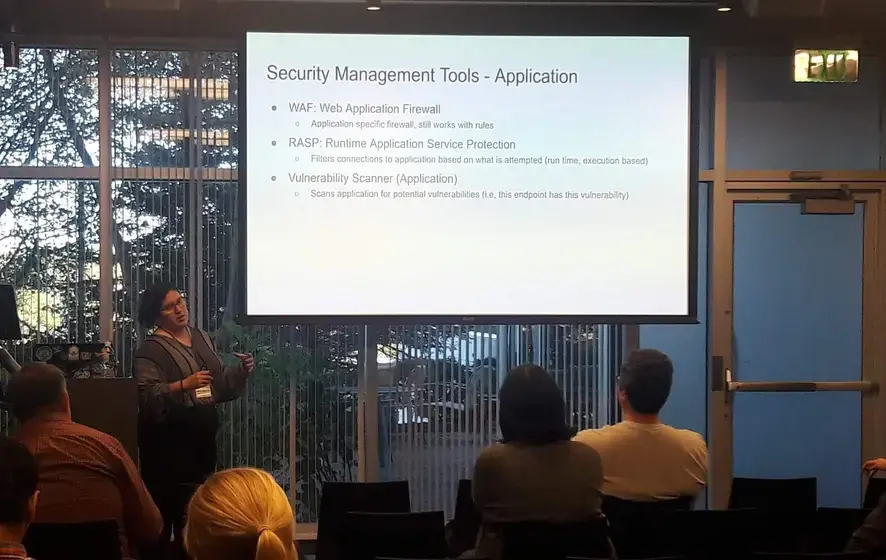Diving Into Data
In October 2019, the National Gallery of Art became the first American art museum to invite six teams of data scientists and art historians to analyze, contextualize, and visualize its permanent collection data, an effort that culminated in “Coding Our Collection,” a two-day Datathon.
Paulina Valdivieso ’19, who studies Computer Science and Public Policy, joined a cohort of researchers, who hailed from institutions across the country, including Carnegie Mellon University, Duke University, George Mason University, Macalester College, New College of Florida, University of California, Los Angeles, and Williams College.
At Bennington, Valdivieso works as a security intern for the Office of Technology. Her supervisor, Director of Information Technology Jude Higdon, recommended her for the Datathon team.
“The National Gallery of Art was interested in doing a quantitative analysis of the art holdings they have,” said Valdivieso. “Their holdings are extensive, but what is shown is not entirely representative of the collection they actually have.”
Valdivieso’s four-person team analyzed how the NGA’s acquisition history has changed over time.
“One example I found fascinating was that paintings constituted 63% of the NGA’s highlighted works, but only constituted 3% of the collection they had,” said Valdivieso. “We looked at highlights as compared to the whole collection, and we also looked into the types of media that were acquired by each director.”
The NGA was established in 1937, but over this time, it has only had five directors. Kaywin Feldman, the current director of the NGA, assumed the role in March 2019. Already, said Valdivieso, Feldman’s acquisition history has shifted from that of her predecessors, who emphasized prints over all other mediums.
“You can’t compare by number of pieces, since Kaywin’s been in the position for less than a year, but percentage-wise, she’s skewed toward photographs, which previously had been acquired at the lowest rate,” said Valdivieso.
Examining bought art from a data perspective, she said, allows “for interesting narratives to pop up,” and may signal shifting tastes and values in the artworld at large.



At Bennington
Through her work on campus and beyond, Valdivieso has become a skilled public speaker and is particularly passionate about information technology and data security.
“I’ve been interested in information security my whole life,” said Valdivieso, who first discovered the field through her fascination with the hacktivist collective Anonymous.
“It was incredible to discover the widespread consequences that computer hacking could have on that scale,” said Valdivieso. “So I actually was interested in cyber security before I was interested in computer programming. I learned to hack before I learned how to code, which is kind of unusual.”
Valdivieso’s advanced work in Computer Science, which she completed in Spring 2019, was based around the motto “do your job right.”
“I explored how and why it’s important to do your job right in cyber security,” said Valdivieso. “While this is the goal in any career, in security, I think there’s a moral responsibility—if the job’s not done right, it can lead to data breaches, identity theft, or extortion. There can be a lot of unforeseen implications if people’s data isn’t secure.”
The catch, Valdivieso said, is that people responsible for security don’t always see the full picture in this ever-evolving field. Her advanced work explored the myriad causes of data breaches, as well as ways to remediate the communications problems and knowledge gaps that often contribute to lax security.
“Technicians and administrators look at security in different ways,” said Valdivieso.
To bridge this gap, Valdivieso’s project also involved making guides of security requirements geared toward each audience.
“I drafted a list of security requirements that should be the bare minimum for any small-to-medium-sized companies that use tech,” said Valdivieso. “One version contained technical information needed to implement these procedures, and the other gave a top-level risk-management perspective on systems for managers.”
Valdivieso presented her work at the Vermont Academy of Arts and Science’s student symposium, and then she submitted it to The Diana Initiative’s information security conference, where it was accepted.
Throughout her time at Bennington, Valdivieso has also presented on enterprise security monitoring tools at OWASP’s Boston conference, been invited to speak to the University of Massachusetts Amherst’s Cyber Security Club and ACM-W Society, and has participated in numerous other engagements.
The most important key for fellow students hoping to land conference lectures or other public speaking engagements, she says, is to take the leap and “start trying the things you want to do.”
“Bennington is a place that encourages you to explore things,” said Valdivieso. “People have asked me how I get into conferences, and I tell them I submitted in response to their calls for papers. There’s no secret formula; it’s just a matter of taking one step, and that can open up the path in front of you.”
By Natalie Redmond, Associate Writer